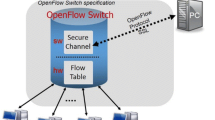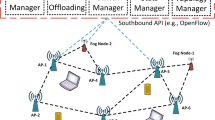Abstract
Osmotic Computing represents a glue solution able to manage the deployment and orchestration of interconnected microelements across heterogeneous physical and virtual infrastructures (e.g., IoT, Edge and Cloud nodes) according to the behavior of hardware and software components during the time. The adoption of Osmotic Computing is challenging, but addressing networking issues is a key research topic due to the emergence of new problems in terms of QoS requirements. In this paper, we analyze how to exploit well-known networking solutions, such as the Dijkstra’s algorithm, and Big Data oriented technologies, such as the Hadoop and MapReduce, to provide efficient newtorking functionalities in Osmotic Computing. In particular, our objective is to minimize the routing path computation time in the software defined network (SDN) at the basis of microelement networking, as well as to ensure a global view and a high level of dynamism of our network topology. To accomplish this task, we process routing tables through a MapReduce based implementation of the Dijkstra’s algorithm whenever a topology change occurs, and we export routing results into the SDN. Our experimental results show that our networking strategy drastically reduces the best path computation time whenever the network of microelements is very large.













Similar content being viewed by others
References
Gartner Says 8.4 Billion Connected “Things” Will Be in Use in 2017, Up 31 Percent From 2016, 2017. https://www.gartner.com/newsroom/id/3598917
Villari, M., Fazio, M., Dustdar, S., Rana, O., Ranjan, R.: Osmotic computing: a new paradigm for edge/cloud integration. IEEE Cloud Comput. 3, 76–83 (2016)
Villari, M., Celesti, A., Fazio, M.: Towards osmotic computing: looking at basic principles and technologies. In: Advances in Intelligent Systems and Computing, pp. 906–915. Springer, Cham (2017)
Datta, S.K., Bonnet, C.: Next-generation, data centric and end-to-end IoT architecture based on microservices. In: 2018 IEEE International Conference on Consumer Electronics—Asia (ICCE-Asia), pp. 206–212 (2018)
Apache Hadoop. https://hadoop.apache.org/. Accessed June 2019
Apache Spark. https://spark.apache.org/. Accessed June 2019
Hazarika, A.V., Ram, G.J.S.R., Jain, E.: Performance comparision of Hadoop and spark engine. In: 2017 International Conference on I-SMAC (IoT in Social, Mobile, Analytics and Cloud) (I-SMAC), pp. 671–674 (2017)
Wakde, A., Shende, P., Waydande, S., Uttarwar, S., Deshmukh, G.: Comparative analysis of hadoop tools and spark technology. In: 2018 Fourth International Conference on Computing Communication Control and Automation (ICCUBEA), pp. 1–4 (2018)
Chebbi, I., Boulila, W., Mellouli, N., Lamolle, M., Farah, I.R.: A comparison of big remote sensing data processing with hadoop mapreduce and spark. In: 2018 4th International Conference on Advanced Technologies for Signal and Image Processing (ATSIP), pp. 1–4 (2018)
Zheng, X., Tian, J., Xiao, X., Cui, X., Yu, X.: A heuristic survivable virtual network mapping algorithm. Soft Comput. 1–11 (2018)
Zhou, W., Jia, J.: Lightweight web3d visualization framework using Dijkstra-based mesh segmentation. In: Lecture Notes in Computer Science (including subseries Lecture Notes in Artificial Intelligence and Lecture Notes in Bioinformatics), vol. 10345 LNCS, pp. 138–151 (2017)
Zhang, S.M., Sangaiah, A.: Reliable design for virtual network requests with location constraints in edge-of-things computing. EURASIP J. Wirel. Commun. Netw. 2018 (2018)
Muñoz, R., Vilalta, R., Yoshikane, N., Casellas, R., Martínez, R., Tsuritani, T., Morita, I.: Integration of IoT, transport SDN, and edge/cloud computing for dynamic distribution of IoT analytics and efficient use of network resources. J. Lightwave Technol. 36, 1420–1428 (2018)
Kaur, K., Garg, S., Aujla, G., Kumar, N., Rodrigues, J., Guizani, M.: Edge computing in the industrial internet of things environment: software-defined-networks-based edge-cloud interplay. IEEE Commun. Mag. 56, 44–51 (2018)
Guo, H., Liu, J.: Collaborative computation offloading for multi-access edge computing over fiber-wireless networks. IEEE Trans. Veh. Technol. (2018)
Liu, M., Mao, Y., Leng, S., Mao, S.: Full-duplex aided user virtualization for mobile edge computing in 5g networks. IEEE Access 6, 2996–3007 (2017)
He, Y., Yu, F.R., Zhao, N., Leung, V., Yin, H.: Software-defined networks with mobile edge computing and caching for smart cities: a big data deep reinforcement learning approach. IEEE Commun. Mag. 55, 31–37 (2017)
Huang, C., Chiang, M., Dao, D., Su, W., Xu, S., Zhou, H.: V2v data offloading for cellular network based on the software defined network (SDN) inside mobile edge computing (MEC) architecture. IEEE Access (2018)
Wang, K., Yin, H., Quan, W., Min, G.: Enabling collaborative edge computing for software defined vehicular networks. IEEE Netw. (2018)
Lin, C., Xue, C., Hu, J., Li, W.Z.: Hierarchical architecture design of computer system. Jisuanji Xuebao Chin. J. Comput. 40, 1996–2017 (2017)
Liu, Z., Yang, H., Kou, S.: Shared protection algorithm based on virtual network embedding framework in fiber-wireless access network (2017)
Wang, M., Liu, J., Mao, J., Cheng, H., Chen, J., Qi, C.: Routeguardian: constructing. Tsinghua Sci. Technol. 22, 400–412 (2017)
Wang, C., Yan, S.: Scaling SDN network with self-adjusting architecture. In: IEEE International Conference on Electronic Information and Communication Technology (ICEICT), Harbin, pp. 116–120 (2016)
Vig, A., Kushwah, R.S., Tomar, R.S., Kushwah, S.S.: Autonomous agent based shortest path load balancing in cloud. In: 8th International Conference on Computational Intelligence and Communication Networks (CICN), Tehri, pp. 33–37 (2016)
Rattanawadee, P., Ruengsakulrach, N., Saivichit, C.: The transmission time analysis of IPTV multicast service in SDN/openflow environments (2015)
Liu, F., Chen, X., An, W., Peng, Y., Cao, J., Zhang, Y.: Minimizing transmission cost for multiple service function chains in SDN/NFV networks, vol. 2017, pp. 1–6 (2018)
Li, Y., Orgerie, A.C., Rodero, I., Amersho, B.L., Parashar, M., Menaud, J.M.: End-to-end energy models for edge cloud-based IoT platforms: application to data stream analysis in IoT. Future Gener. Comput. Syst. 87, 667–678 (2018)
Dong, S., Gao, Z., Pirbhulal, S., Bian, G.B., Zhang, H., Wu, W., Li, S.: IoT-based 3d convolution for video salient object detection. Neural Comput. Appl. (2019)
Chen, M., Xiong, J., Ma, C., Zhao, Q., Feng, S.: Real-time buffering, parallel processing and high-speed transmission system for multi-channel video images based on ADER. In: 2019 International Conference on Computer, Network, Communication and Information Systems (CNCI 2019). Atlantis Press (2019)
What is OpenFlow? Definition and How it Relates to SDN. (https://www.sdxcentral.com/networking/sdn/definitions/what-is-openflow/) Last access: (June 2019)
The Network Simulator - ns-2. https://www.isi.edu/nsnam/ns/. Accessed June 2019
Opnet Network Simulator. http://opnetprojects.com/opnet-network-simulator/. Accessed June 2019
Mininet An Instant Virtual Network on your Laptop (or other PC). http://mininet.org/. Accessed June 2019
What is a Floodlight Controller? https://www.sdxcentral.com/networking/sdn/definitions/what-is-floodlight-controller/. Accessed June 2019
Opendaylight. https://www.opendaylight.org/. Accessed June 2019
What is FlowVisor? https://searchnetworking.techtarget.com/definition/FlowVisor. Accessed June 2019
Ashouri, M., Setayesh, S.: Enhancing the performance and stability of SDN architecture with a fat-tree based algorithm (2018)
Duque, J.P., Beltrán, D.D., Leguizamón, G.P.: Opendaylight vs. floodlight: comparative analysis of a load balancing algorithm for software defined networking. Int. J. Commun. Netw. Inf. Secur. 10, 348–357 (2018)
Alrashedy, K., Kimmett, B., Gulliver, T.A.: Performance of software-defined networking controllers for different network topologies. In: IEEE Pacific Rim Conference on Communications, Computers and Signal Processing (PACRIM) (2017)
Ganglia Monitoring System. http://ganglia.sourceforge.net/. Accessed June 2019
Acknowledgements
This work has been supported by C4E.
Author information
Authors and Affiliations
Corresponding author
Additional information
Publisher's Note
Springer Nature remains neutral with regard to jurisdictional claims in published maps and institutional affiliations.
Rights and permissions
About this article
Cite this article
Fazio, M., Buzachis, A., Galletta, A. et al. A Map-Reduce Approach for the Dijkstra Algorithm in SDN Over Osmotic Computing Systems. Int J Parallel Prog 49, 347–375 (2021). https://doi.org/10.1007/s10766-021-00693-3
Received:
Accepted:
Published:
Issue Date:
DOI: https://doi.org/10.1007/s10766-021-00693-3




